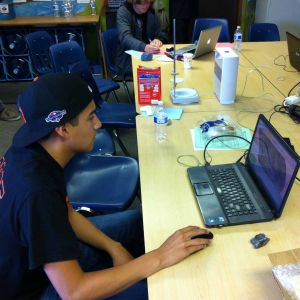By Camila Gutierrez | PCP PIRE Staff
My name is Camila Gutierrez and I am a senior mathematics major at the University of Florida. My interest in museum education began when I interned at a children’s museum in Naples, Florida as a UF Noyce Scholar. While an intern, I implemented STEM learning lessons for the museum’s summer camps, and created a technology based workshop using Snap Circuits.

This past summer I have had the opportunity to be a collections and research assistant at the Florida Museum of Natural History. As a collections assistant I began making replicas of Megalodon teeth and other fossils for educational and research purposes. Then I began to work on 3D scanning for Dr. Aaron Wood’s research on astragali—looking into the evolution of mammalian ankle bones.
By working on this project I have learned to be efficient when I scan, as well as problem solve when scanning different sizes of fossils. I am also working with Claudia Grant, a doctoral student exploring the benefits of using 3D scanning in science classes.
I traveled with Claudia to California to assist with workshops involving 12 teachers and 17 students on 3D scanning. During this trip we were able to see how feasible 3D scanning would be in a classroom environment. We are working with teachers from different schools to determine the individual needs for each teacher to be able to do 3D scanning. We answered questions about the duration for this project, the kind of training that the teachers will receive, and how paleontologists can help them with creative content for their science lessons. This trip was the first time that we were able to see students interact with the software and process of 3D scanning. We saw that students were very excited for this new technology in their school, and they were able to pick up the process of scanning really quickly. We want to teach students science lessons through 3D scanning, as well as have them be part of the process of creating a high fidelity model for the purpose of scientific research.
I am very excited for the future of this project because there is a need for this type of technology in the classroom. For me it is really rewarding to work with teachers who are interested in taking challenges and learning new software for their students to experience and learn.
Por Camila Gutierrez | PCP PIRE Personal
Mi nombre es Camila Gutiérrez y soy estudiante de la Universidad de la Florida cursando mi último año en matemáticas. Mi interés hacia la educación de museos empezó cuando hice una pasantía en el museo de los niños en la ciudad de Naples, Florida, como consejera académica. Durante mi pasantía, tuve la oportunidad de implementar talleres de aprendizaje STEM para los campamentos de verano y también creé un taller basado en la tecnología donde utilize Snap Circuits.

El verano pasado tuve la oportunidad de ser asistente de investigación y colecciones en el Museo de Historia Natural de Florida. Como asistente comencé a hacer réplicas de dientes de Megalodon y otros fósiles con fines educativos y de investigación. Luego empecé a trabajar en la digitalización 3D de astrágalos (hueso del tobillo) para la investigación del Dr. Aaron Wood–basada en la evolución de este hueso en los mamíferos.
Al trabajar en este proyecto he aprendido a ser eficiente al momento de escanear y resolver problemas que requieren escanear diferentes tamaños de fósiles. También estoy trabajando en colaboración con Claudia Grant, una estudiante de doctorado, explorando los beneficios del uso de la digitalización 3D en el departamento de ciencias.
Junto a Claudia, hice un viaje a California para asesorar talleres 3D con la participación de 12 profesores y 17 estudiantes. Durante este viaje nos dimos cuenta de la flexibilidad de hacer escaneos 3D en un ambiente estudiantil. En este momento, estamos trabajando con maestros de diferentes escuelas para determinar las necesidades individuales de cada profesor para poder hacer el escaneo 3D. Durante este proceso pudimos responder preguntas acerca de la duración de este proyecto, el tipo de formación que recibirán los maestros y cómo los paleontólogos los pueden ayudar con el contenido creativo para sus clases de ciencias. En este viaje observamos por primera vez la interacción de los estudiantes con el software y el proceso de digitalización 3D. También presenciamos la motivación de los estudiantes con esta nueva tecnología y pudimos ver lo rápido que aprendieron el proceso de escaneo. Nuestro propósito es enseñar las clases de ciencias a través de la digitalización 3D para que los estudiantes sean parte del proceso de creación de un modelo de alta fidelidad con fines de investigación científica.
Estoy muy entusiasmada por el futuro de este proyecto porque hay una necesidad de este tipo de tecnología en un ambiente escolar. Para mí es muy gratificante trabajar con maestros que están interesados en asumir retos y aprender nuevos softwares para que sus estudiantes experimenten y aprendan.